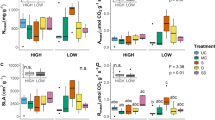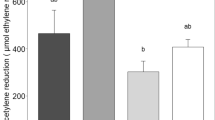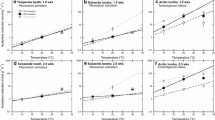Abstract
In the tundra, mosses play an important functional role regulating belowground and ecosystem processes, but there is still considerable uncertainty about how tundra moss communities will respond to climate change. We examined the effects of 5 years of in situ air and soil warming on net primary productivity (NPP), carbon (C) and nitrogen (N) isotope signatures (δ13C and δ15N), and C:N in dominant Alaskan tundra mosses. Air warming increased mean air temperatures by up to 0.5°C and resulted in an 80–90% reduction in NPP in the feather moss Pleurozium and the peat moss Sphagnum. Soil warming increased permafrost thaw depth by 12–18%, upper soil water content by 23–27%, and resulted in a threefold increase in Sphagnum NPP. δ13C was positively correlated with moss NPP, and increased by 0.5–1‰ in all mosses under soil warming. C:N was reduced in Sphagnum and Pleurozium, due to increases in tissue %N in the soil warming treatment, suggesting that moss N availability could increase as temperatures increases. Higher N availability in warmer conditions, however, may be offset by unfavorable moisture conditions for moss growth. Similar to responses in tundra vascular plant communities, our results forecast interspecific differences in productivity among tundra mosses. Specifically, air warming may reduce productivity in Sphagnum and Pleurozium, but soil warming could offset this response in Sphagnum. Such responses may lead to changes in tundra moss community structure and function as temperatures increase that have the potential to alter tundra C and N cycling in a future climate.




Similar content being viewed by others
References
ACIA. 2004. Impacts of a warming Arctic. Cambridge: Cambridge University Press.
Arft AM, Walker MD, Gurevitch JEA, Alatalo JM, Bret-Harte MS, Dale M, Wookey PA. 1999. Responses of tundra plants to experimental warming: meta-analysis of the international tundra experiment. Ecol Monogr 69(4):491–511.
Bellolio-Trucco G, Ireland RR. 1990. A taxonomic study of the moss genus Dicranum (Dicranaceae) in Ontario and Quebec. Can J Bot 68(4):867–909.
Benscoter BW, Vitt DH. 2007. Evaluating feathermoss growth: a challenge to traditional methods and implications for the boreal carbon budget. J Ecol 95:151–8.
Beringer J, Lynch AH, Chapin FS, Mack M, Bonan GB. 2001. The representation of Arctic soils in the land surface model: the importance of mosses. J Clim 14(15):3324–35.
Borner AP, Kielland K, Walker MD. 2008. Effects of simulated climate change on plant phenology and nitrogen mineralization in Alaskan Arctic tundra. Arct Antarct Alp Res 40:27–38.
Bragazza L, Limpens J, Gerdol R, Grosvernier P, Hajek M, Hájek T, Tahvanainen T. 2005. Nitrogen concentration and δ15N signature of ombrotrophic Sphagnum mosses at different N deposition levels in Europe. Glob Change Biol 11(1):106–14.
Brooker R, van derWal R. 2003. Can soil temperature direct the composition of high Arctic plant communities? J Veg Sci 14:535–42.
Camill P, Lynch JA, Clark JS, Adams JB, Jordan B. 2001. Changes in biomass, aboveground net primary production, and peat accumulation following permafrost thaw in the boreal peatlands of Manitoba, Canada. Ecosystems 4(5):461–78.
Campioli M, Samson R, Michelsen A, Jonasson S, Baxter R, Lemeur R. 2009. Nonvascular contribution to ecosystem NPP in a subarctic heath during early and late growing season. Plant Ecol 202(1):41–53.
Chapin FS, Shaver GR. 1985. Individualistic growth response of tundra plant species to environmental manipulations in the field. Ecology 66(2):564–76.
Chapin FS, Shaver GR. 1996. Physiological and growth responses of Arctic plants to a field experiment simulating climatic change. Ecology 77:822–40.
Chapin FS, Shaver GR, Giblin AE, Nadelhoffer KJ, Laundre JA. 1995. Responses of Arctic tundra to experimental and observed changes in climate. Ecology 76:694–711.
Coe KK, Belnap J, Sparks JP. 2012. Precipitation-driven carbon balance controls survivorship of desert biocrust mosses. Ecology 93(7):1626–36.
Clymo RS. 1970. Growth of Sphagnum: methods of measurement. J Ecol 58:13–49.
DeLuca TH, Zackrisson O, Nilsson MC, Sellstedt A. 2002. Quantifying nitrogen-fixation in feather moss carpets of boreal forests. Nature 419(6910):917–20.
DeLuca TH, Zackrisson O, Gentili F, Sellstedt A, Nilsson MC. 2007. Ecosystem controls on nitrogen fixation in boreal feather moss communities. Oecologia 152(1):121–30.
Dilks TJK, Proctor MCF. 1979. Photosynthesis, respiration and water content in bryophytes. New Phytol 82(1):97–114.
Dorrepaal E, Aerts R, Cornelissen JH, Callaghan TV, Van Logtestijn RS. 2004. Summer warming and increased winter snow cover affect Sphagnum fuscum growth, structure and production in a sub-arctic bog. Glob Change Biol 10(1):93–104.
Elmendorf SC, Henry GH, Hollister RD, Björk RG, Boulanger-Lapointe N, Cooper EJ, Wipf S. 2012a. Plot-scale evidence of tundra vegetation change and links to recent summer warming. Nature Climate Change 2(6):453–7.
Elmendorf SC, Henry GH, Hollister RD, Björk RG, Bjorkman AD, Callaghan TV, Wookey PA. 2012b. Global assessment of experimental climate warming on tundra vegetation: heterogeneity over space and time. Ecol Lett 15(2):164–75.
Epstein HE, Calef MP, Walker MD, Chapin FS, Starfield AM. 2004. Detecting changes in Arctic tundra plant communities in response to warming over decadal time scales. Glob Change Biol 10(8):1325–34.
Forbes BC, Fauria M, Zetterberg P. 2010. Russian Arctic warming and ‘greening’ are closely tracked by tundra shrub willows. Glob Change Biol 16(5):1542–54.
Gornall JL, Jónsdóttir IS, Woodin SJ, Van der Wal R. 2007. Arctic mosses govern below-ground environment and ecosystem processes. Oecologia 153(4):931–41.
Gunnarsson U, Granberg G, Nilsson M. 2004. Growth, production and interspecific competition in Sphagnum: effects of temperature, nitrogen and sulphur treatments on a boreal mire. New Phytol 163(2):349–59.
Gunnarsson U. 2005. Global patterns of Sphagnum productivity. Journal of Bryology 27(3):269–79.
Handley LL, Austin AT, Stewart GR, Robinson D, Scrimgeour CM, Raven JA, Schmidt S. 1999. The 15N natural abundance (·15N) of ecosystem samples reflects measures of water availability. Funct Plant Biol 26(2):185–99.
Hedenäs LARS, Bisang IRENE. 2004. Key to European Dicranum species. Herzogia 17:179–97.
Henry GHR, Molau U. 1997. Tundra plants and climate change: the International Tundra Experiment (ITEX). Glob Change Biol 3(S1):1–9.
Hobbie SE, Chapin FS. 1998. Response of tundra plant biomass, aboveground production, nitrogen, and CO2 flux to experimental warming. Ecology 79:1526–44.
Hobbie SE, Shevtsova A, Chapin FS. 1999. Plant responses to species removal and experimental warming in Alaskan tussock tundra. Oikos 84:417–34.
Houghton JT, Filho LGM, Callander BA, Harris N, Kattenberg A, Maskell K, Eds. 1996. Climate change 1995: the science of climate change. Cambridge: Cambridge University Press.
Houle D, Bilodeau Gauthier S, Paquet S, Planas D, Warren A. 2006. Identification of two genera of N2-fixing cyanobacteria growing on three feather moss species in boreal forests of Quebec, Canada. Botany 84(6):1025–9.
Hudson JMG, Henry GHR. 2009. Increased plant biomass in a high Arctic heath community from 1981 to 2008. Ecology 90:2657–63.
IPCC. 2013. Climate change 2013: the physical science basis. Cambridge: Cambridge University Press.
Jonasson S, Michelsen A, Schmidt IK, Nielsen EV. 1999. Responses in microbes and plants to changed temperature, nutrient, and light regimes in the Arctic. Ecology 80(6):1828–43.
Lang SI, Cornelissen JH, Shaver GR, Ahrens M, Callaghan TV, Molau U, Aerts R. 2012. Arctic warming on two continents has consistent negative effects on lichen diversity and mixed effects on bryophyte diversity. Glob Change Biol 18(3):1096–107.
Lindo Z, Nilsson MC, Gundale MJ. 2013. Bryophyte-cyanobacteria associations as regulators of the northern latitude carbon balance in response to global change. Glob Change Biol 19(7):2022–35.
Markham JH. 2009. Variation in moss-associated nitrogen fixation in boreal forest stands. Oecologia 161(2):353–9.
McNeil P, Waddington JM. 2003. Moisture controls on Sphagnum growth and CO2 exchange on a cutover bog. J Appl Ecol 40(2):354–67.
Natali SM, Schuur EAG, Trucco C, Hicks Preis CE, Crummer KG, Baron Lopez AF. 2011. Effects of experimental warming of air, soil and permafrost on carbon balance in Alaskan tundra. Glob Change Biol 17(3):1394–407.
Natali SM, Schuur EAG, Rubin RL. 2012. Increased plant productivity in Alaskan tundra as a result of experimental warming of soil and permafrost. J Ecol 100(2):488–98.
Nelson FE, Anisimov OA, Shiklomanov NI. 2001. Subsidence risk from thawing permafrost. Nature 410(6831):889–90.
Osterkamp TE, Romanovsky VE. 1999. Evidence for warming and thawing of discontinuous permafrost in Alaska. Permafrost Periglac Process 10:17–37.
Press MC, Potter JA, Burke MJW, Callaghan TV, Lee JA. 1998. Responses of a subarctic dwarf shrub heath community to simulated environmental change. J Ecol 86:315–27.
Pries CEH, Schuur EAG, Crummer KG. 2012. Holocene carbon stocks and carbon accumulation rates altered in soils undergoing permafrost thaw. Ecosystems 15(1):162–73.
R Core Team. 2015. R: a language and environment for statistical computing. R Foundation for Statistical Computing, Vienna, Austria. ISBN 3-900051-07-0, URL http://www.R-project.org/.
Rice SK, Giles L. 1996. The influence of water content and leaf anatomy on carbon isotope discrimination and photosynthesis in Sphagnum. Plant Cell Environ 19(1):118–24.
Rice SK. 2000. Variation in carbon isotope discrimination within and among Sphagnum species in a temperate wetland. Oecologia 123(1):1–8.
Rydin H, Jeglum JK. 2013. The biology of peatlands, 2e. Oxford: Oxford University Press.
Schipperges B, Rydin H. 1998. Response of photosynthesis of Sphagnum species from contrasting microhabitats to tissue water content and repeated desiccation. New Phytol 140:677–84.
Schuur EAG, Crummer KG, Vogel JG, Mack MC. 2007. Plant species composition and productivity following permafrost thaw and thermokarst in Alaskan tundra. Ecosystems 10:280–92.
Schuur EAG, Vogel JG, Crummer KG, Lee H, Sickman JO, Osterkamp TE. 2009. The effect of permafrost thaw on old carbon release and net carbon exchange from tundra. Nature 459:556–9.
Skre O, Oechel WC, Miller PM. 1983. Moss leaf water content and solar radiation at the moss surface in a mature black spruce forest in central Alaska. Can J Res 13(5):860–8.
Solheim B, Endal A, Vigstad H. 1996. Nitrogen fixation in Arctic vegetation and soils from Svalbard, Norway. Polar Biol 16(1):35–40.
Soudzilovskaia NA, Bodegom PM, Cornelissen JH. 2013. Dominant bryophyte control over high-latitude soil temperature fluctuations predicted by heat transfer traits, field moisture regime and laws of thermal insulation. Funct Ecol 27(6):1442–54.
Street LE, Subke JA, Sommerkorn M, Sloan V, Ducrotoy H, Phoenix GK, Williams M. 2013. The role of mosses in carbon uptake and partitioning in Arctic vegetation. New Phytol 199(1):163–75.
Tape KEN, Sturm M, Racine C. 2006. The evidence for shrub expansion in northern Alaska and the Pan-Arctic. Glob Change Biol 12(4):686–702.
Toet S, Cornelissen JH, Aerts R, van Logtestijn RS, de Beus M, Stoevelaar R. 2006. Moss responses to elevated CO2 and variation in hydrology in a temperate lowland peatland. Plant Ecol 182(1–2):27–40.
van Wijk MT, Clemmensen KE, Shaver GR, Williams M, Callaghan TV, Chapin FS. 2004. Long-term ecosystem level experiments at Toolik Lake, Alaska, and at Abisko, Northern Sweden: generalizations and differences in ecosystem and plant type responses to global change. Glob Change Biol 10:105–23.
Williams TG, Flanagan LB. 1996. Effect of changes in water content on photosynthesis, transpiration and discrimination against 13CO2 and C18O16O in Pleurozium and Sphagnum. Oecologia 108(1):38–46.
Wahren CH, Walker MD, Bret-Harte MS. 2005. Vegetation responses in Alaskan Arctic tundra after 8 years of a summer warming and winter snow manipulation experiment. Glob Change Biol 11(4):537–52.
Walker MD. 1996. Community baseline measurements for ITEX studies. In: Molau U, Mølgaard P, Eds. International tundra experiment (ITEX) manual. Copenhagen: Danish Polar Center. p 39–41.
Walker MD, Wahren CH, Hollister RD, Henry GH, Ahlquist LE, Alatalo JM, Wookey PA. 2006. Plant community responses to experimental warming across the tundra biome. Proc Natl Acad Sci USA 103(5):1342–6.
Acknowledgments
This material is based upon work supported by the U.S. Department of Energy Office of Science, Office of Biological and Environmental Sciences Division Terrestrial Ecosystem Sciences program under Award Number DE-SC0006982. Support was also provided by NSF LTER #1026415 and NSF ARC #1203777 as well as the National Parks Vital Signs Inventory and Monitoring Program. We also wish to thank John Krapek, Elizabeth Webb, J. Simon McClung, and Catherine Johnston for assistance with field sampling and site maintenance, and Elaine Pegoraro for compiling moss point-framing data for biomass and NPP analyses. Sarah Stehn was invaluable in field identification of mosses at our site.
Author information
Authors and Affiliations
Corresponding author
Additional information
Author contributions
KKDC conceived and designed the study, performed research, analyzed data, and wrote the manuscript. MM and GC analyzed data and contributed to manuscript revisions. VS performed field research, developed models, and contributed to manuscript revisions. KGC performed isotopic analyses. SMN implemented the original field experiment and contributed to manuscript revisions. EAGS designed and supervised the field experiment and contributed to manuscript revisions.
Rights and permissions
About this article
Cite this article
Deane-Coe, K.K., Mauritz, M., Celis, G. et al. Experimental Warming Alters Productivity and Isotopic Signatures of Tundra Mosses. Ecosystems 18, 1070–1082 (2015). https://doi.org/10.1007/s10021-015-9884-7
Received:
Accepted:
Published:
Issue Date:
DOI: https://doi.org/10.1007/s10021-015-9884-7




